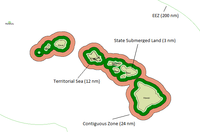JA:Tag:boundary=maritime
 |
| 説明 |
|---|
| 国連の海上法で規定された様々なレベルの海上の境界線 |
| グループ: 境界線 |
| 適用できる要素 |
| 依存するタグ |
| 状態:承認 |
| ツール |

内陸国以外のほとんどの国には海洋上の境界線があります。 海洋法に関する国際連合条約 により、国家は低潮線から12海里 (22.227キロメートル) まで (その範囲が他の国家の領海と干渉しない限り) 領海を宣言することができるとされています。この距離は、海上の国境すべてに適用されるわけではありません: たとえば、イギリス海峡は最も狭い箇所で34kmしかありません。このような場合、国境線は海峡の中央に引かれます。しかし、多くの国境は海岸線から22kmのところに引かれます。
OpenStreetMapで海岸線を描く場合のルールは “海が右、陸が左” (島の海岸線は必ず反時計回りになります) なので、海洋上の境界線は必ず海岸線の右側になります。しかし、海洋上の境界線はウェイの方向に制限はなく、方向が関係ないポリゴンによって海上の領域を区切ることになります。
海上の境界線は閉じていないこともよくあります。特に排他的経済水域や延長大陸棚 (関係する複数の国家の間で国際的な合意がとれていない場合) などではよく見られることです。If some part of the EEZ is missing, the area is implicitly limited by the territorial waters and by the shortest segments joining each ending node of the EEZ to the territorial waters; when territorial waters are not delimited between two countries, they are also limited by their contiguous zone or if it can be defined, otherwise by their baselines; in frequent cases, there's not even any baseline clearly defined and these maritime areas will be limited to the coastline.
境界リレーション
国境
領海の境界線 (12 海里線) は、陸地の境界と同様に boundary リレーションに含めます。
国内の境界線
国によっては行政区画にも海上の境界が定義されています。そのような場合、該当する区画の boundary リレーションにウェイを含めます。
In the United States of America, NOAA nautical charts specify in Note X:
"Within the 12-nautical mile territorial sea, established by Presidential Proclamation, some federal laws apply. The Three Nautical Mile Line, previously identified as the outer limit of the territorial sea, is retained as it continues to depict the jurisdictional limit of the other laws. The 9-nautical mile Natural Resource Boundary off the Gulf coast of Florida, Texas, and Puerto Rico, and the Three Nautical Mile Line elsewhere remain in most cases the inner limit of Federal fisheries jurisdiction and the outer limit of the jurisdiction of the states. The 24-nautical mile Contiguous Zone and the 200-nautical mile Exclusive Economic Zone were established by Presidential Proclamation. Unless fixed by treaty or the U.S. Supreme Court, these maritime limits are subject to modification."
Therefore, OpenStreetMap should extend state and county boundaries 3 nautical miles offshore (or 9 nautical miles offshore where applicable). These boundaries should not hug or intersect or roam around the coastline except where such boundaries separate one county (or county equivalent) from another.
基線
The baseline from which the territorial sea is measured is mainly the low-water line along the coast as marked on large-scale charts officially recognized by the coastal state. Unfortunately, natural=coastline should be placed at mean high water spring (MHWS). The base line draws often lines across fjords or gulfs, all navigational waters inside the base line are defined as inshore or protected water. It also exist straight baselines or archipelagic baselines.
領海(12海里)
A state's territorial sea extends up to 12 nautical miles (22 km) from its baseline. If this would overlap with another state's territorial sea, the border is taken as the median point between the states' baselines, unless the states in question agree otherwise. A state can also choose to claim a smaller territorial sea (usually 3 nm). Some states do claim territorial sea up to 200 nautical miles (this does not meet the requirements of UNCLOS). There are also some other special cases like the territorial sea of the Philippines based on coordinates. The UN provides a list with maritime claims.
boundary=administrativesince so many had a problem with grouping it together with maritime bordersmaritime=yesto state that this is a maritime border, so it can be rendered correctly/different from land bordersadmin_level=2since it is a national boundaryborder_type=territorialto distinguish it from borders on land
This line should also be member of the border relation surrounding the country.
This line differs from the other maritime boundaries as a result of the vote on Maritime Borders. The agreement was to keep it as boundary=administrative as the land border, but tag it with maritime=yes.
- Potential data sources
- US [1]
接続水域(24海里)
The contiguous zone is a band of water extending from the outer edge of the territorial sea to up to 24 nautical miles (44 km) from the baseline, within which a state can exert limited control.
- Potential data sources
- US [2]
排他的経済水域(EEZ、200海里)
An exclusive economic zone extends from the outer limit of the territorial sea to a maximum of 200 nautical miles (370.4 km) from the territorial sea baseline, thus it includes the contiguous zone. A coastal nation has control of all economic resources within its exclusive economic zone, including fishing, mining, oil exploration, and any pollution of those resources.
その他のメモ
The border of admin_level=2 is not where two entities of admin_level 2 meets, but a continuous line around one entity of admin_level 2, therefore use admin_level 2 on the territorial border.
利用できる情報源
- United Nations Laws of the Sea: The UN DOALOS have a database over all maritime border claims. There is no apparent license on the data and this is the borders definitions. But the database is a database of different PDF files with coordinates of baselines and territorial borders. The text has to be parsed by hand and other maritime borders needs to be calculated from the baseline (see maritime borders). Data is to be tagged with
source=UNCLOS - United Nations database of treaties: may be useful, but may not be free; the website terms of use imply non-commercial use, no redistribution and no derivative work. But there are many commercial maps that refer to the database as a source.
関連項目
- Key=boundary (German)
- 元の提案ページ